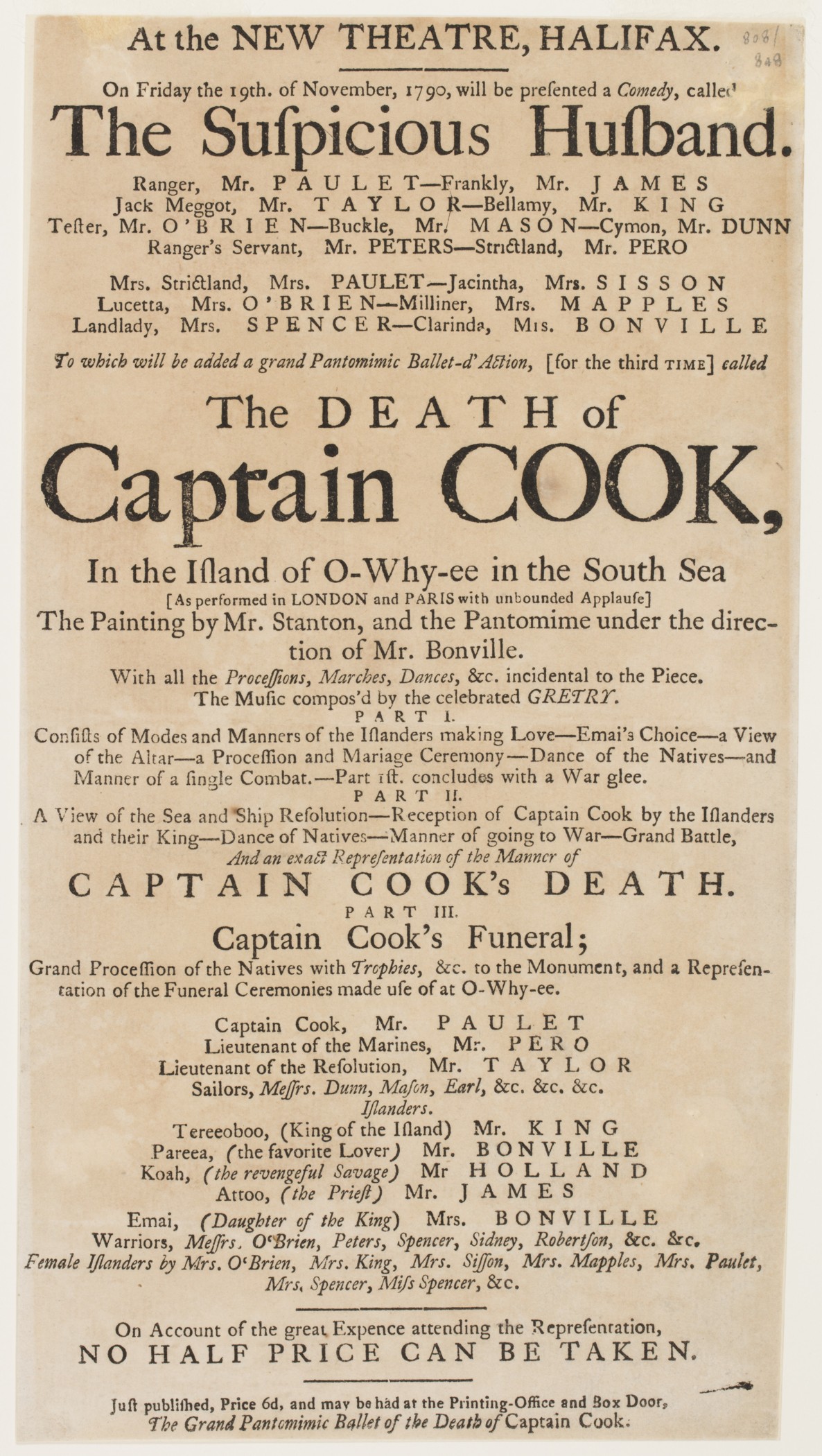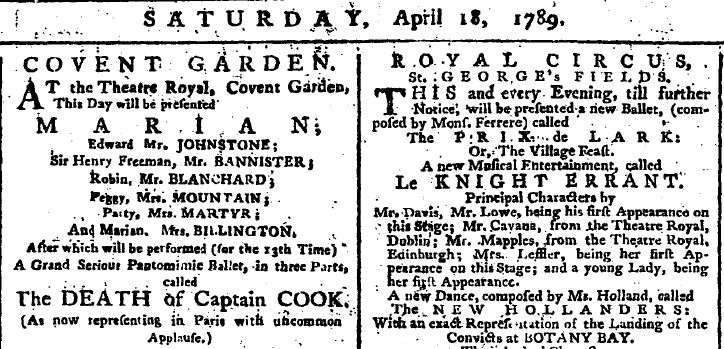
The Death of Captain Cook as portrayed by John Webber. [Public domain]
The Grand Serious Pantomimic Ballet,
The Death of Captain Cook.
In Hawaii, a series of unfortunate events and misunderstandings lead to James Cook being killed along with five of his crew and fifteen islanders. His untimely death elevated the captain to a new level of fame – acquiring the status of a martyr of the enlightenment; a legendary hero. The achievements of his life, and the tragedy of his death, inspired a stream of tributes. Along with an outpouring of eulogies, poems, music, and paintings, perhaps the most curious work was a theatrical extravaganza, The Grand serious pantomimic ballet, The Death of Captain Cook.
Despite being six months into the their Revolution, the French found time to commemorate the great explorer with a dramatic performance called La mort du Capitaine Cook à son troisième voyage au nouveau monde (Captain Cook’s death on his third trip to the new world). It opened in Paris on October 1788 to ‘uncommon applause’. The play was devised by M. Arnould with music by Jean-Baptiste Rochefort and offered fifty-eight different musical items including dance pieces, processions, storms and battles.
The following year The Death of Captain Cook made its debut in London at the Covent Garden Theatre with an adaptation of the French version. It was a grand pantomime with dances and processions, and featured “the original French Music, New dresses, Scenery, Machinery, and other Decorations.” In the first performance, the scene where Cook was stabbed was greeted with tears and hysterics, and it was this dramatic representation of his death which became an important factor in the pantomime’s ongoing success.
Tears and hysterics at the first performance…
Grand serious pantomime
In the 18th century people flocked to the theatre. It was an time of great innovations and exciting developments on the stage with new playhouses opening to cater for the huge demand for plays, ballets, musical performances, operas, and pantomimes. In an age before people could access radio, television or film, the theatre played a significant role in allowing audiences a glimpse a different world. Theatres became important and extremely popular places for socialising and learning the latest news.
The Licensing Act of 1737 was created to restrict the number of theatres in London after a satirical play attacked the Royal family, and the Prime Minister Robert Walpole. The freedom of speech inherent in the theatre was seen as a potential threat to the government and the Licensing Act sought to control and censor all plays. The law dictated that spoken drama was only permitted in the two licensed theatres at Convent Garden and Drury Lane. The Act had the remarkable effect of stimulating a large range of alternative theatrical works as managers looked for legal loopholes, avoiding spoken drama and developing more light-hearted performances. This lead to a plethora of alternative stage productions – everything from acrobatics to melodrama, pantomimes to ballets.
Serious pantomimic ballet was the modern dance of the eighteenth-century Enlightenment. It was variously known as ballet d’action, heroic or tragic ballet, and tragedy in pantomime. It brought new meanings to dance movements, and appealed to both the reason and the senses – the mind and the heart. Its powerful emotive quality delighted audiences.

One critic lamented that the French were the first to commemorate Cook in a stage production, commenting it was “rather disgraceful to England.” This is a curious statement given the popularity of the Omai pantomime which concluded with the death of Cook.
The Story
As in pantomime of Omai, the story bore little resemblance to any actual event. It did, however, give an elaborate depiction of the people and places which Cook had visited. The scene was set on ‘The Island of O-Why-e in the South Sea’. The King of Hawaii is at war and Cook assists in defeating his enemies. The ruler wishes to put the prisoners to death but Cook is able to save them. Nevertheless, he is attacked and murdered by the enemies as they regarded him to be responsible for their defeat.

Mr Fisher as Tereeboo, King of the Island of Owhyhee, in the Death of Captain Cook. Courcell, A. & Creed, G. London 1818. National Library of Australia
On the stage
Creativeness in the new genres of performance lead to rapid advances in stage technology with an increased emphasis on impressive visual effects. The Death of Captain Cook was a triumph of the latest developments in lighting, sound effects, music, dance, and featured authentic costumes. The German-born Philip de Loutherbourg produced magnificent sets for the ballet drawing upon the knowledge of those who had travelled with Cook into the Pacific.
Listen to the Tambourine Dance. Download the score Tambourine Dance.
The music for the ballet was described as most characteristic and included happy, festive music, a tambourine and lively country dance, and a dance with clubs; sections with military and majestic marches, a ‘grande charge’, and finally funeral music. This was performed on French horns, flute, clarinet, bassoon, violins, viola, and cello, with the addition of canons for a resounding effect.
Listen to Danse avec les Massues (A dance with clubs)
Download the score Danse avec les Massues
The script and music are still available, however, no choreography for the dances was notated, as was typical of ballet d’action.
Popularity
…the best of all pantomimes.
A critic of the London performances wrote: “we scarcely ever witnessed the influence of sympathy operate so powerfully upon an audience. The passions of love, jealousy, and grief are finely blended and disposed of in the various scenes with great art.”
Within a year of the London debut, the pantomime was delighting large audiences throughout England. Observers wrote:
…of all pantomimes..this has come nearest to the heart
…rapturous applause
…got up with much taste and splendour
…drew a very elegant and numerous audience
…long and merited attention
…a very crowded audience … received with uncommon marks of applause
This spectacular entertainment went on to become popular throughout the British Isles, Europe and America. Newspaper advertisements and collections of playbills testify to the long-running success of the production. The State Library of New South Wales has twenty playbills dating from the earliest performance in November 1789, through to a revival in 1836. There are six playbills in America from 1793 to 1808 advertising productions in New York, Boston, and Charleston.

At the New Theatre, Halifax, on Friday 19th of November, 1790. Mitchell Library, State Library of New South Wales.
Playbills were cheaply printed adverts-cum-descriptions that were circulated widely to attract audiences. The examples still in existence represent a small fraction of the numbers printed.
This playbill dated 19 November, 1790 comes from the New Theatre, Halifax, England. It give a list of the cast and a detailed synopsis of the three acts.
Newspaper advertisements and reviews provide important information about theatrical works which are available through no other channel. During April and May in 1789, the ballet of The Death of Captain Cook at Covent Garden was running at the same time as “an exact Representation of the Landing of the Convicts at Botany Bay” at the Royal Circus.

Public Advertiser, London. 18 Apr. 1789.
Seventeenth and Eighteenth Century Burney Newspapers Collection
Other versions
In Limerick, another English version was printed in 1790, and a number of related theatrical works were produced on European stages.
Perhaps more curiously were the equestrian versions of the ballet staged by Astley in London, Liverpool, Edinburgh, and Dublin, and by Ricketts in America [link to be added soon].
There are no recorded Australian performances of The Death of Captain Cook. The production demanded elaborate sets and costumes, which would have been beyond the scope of early Australian theatre companies.
Ongoing influence
Some music from the ballet entered into the popular consciousness. The Scottish poet, Robert Burns used the tune Captain Cook’s Death for the song My Mary dear departed shade, and Miss Johnson employed the tune Thou Ling’ring Star in A collection of genuine Scottish melodies. Other tunes which were reprinted included The Pursuit, and the New Duke of York’s March.
The dance with music, Captain Cook’s Country Dance was published by Corri, Dussek & Co. in 1797, perhaps capitalising on the success of the ballet.
In 2001, the Australian conductor and musicologist, Richard Divall (2001) edited and arranged the score http://trove.nla.gov.au/version/44696893
One tract is included on the recording Australia unite! : the road to federation.
We have produced a CD and book featuring Cook related tunes, and other music for early colonial Australia. Shop now
Select Bibliography
Arnould, M. (1788). La mort du capitaine Cook, a son troisieme voyage au nouveau monde: pantomime en quatre actes; représentée pour la première fois sur le Théâtre de l’ambigu-comique, au mois d’octobre 1788: Lagrange.
Dening, G. (1992). Mr Bligh’s bad language: passion, power, and theatre on the Bounty. Cambridge;New York;: Cambridge University Press.
Dickson, A. (2018, 21 Jun 2018 ). 18th Century British Theatre. Retrieved from https://www.bl.uk/restoration-18th-century-literature/articles/18th-century-british-theatre
Hetherington, M., & National Library of Australia. (2001). Cook & Omai : the cult of the South Seas. Canberra: National Library of Australia.
Irving, D. (2005). The Pacific in the Minds and Music of Enlightenment Europe. Eighteenth Century Music Eighteenth Century Music, 2(2), 205-229. doi:10.1017/S1478570605000357
Onesti, S. (2014). Dietro la traccia de’gran maestri. Prassi e poetica del ballo pantomimo italiano negli ultimi quarant’anni del Settecento.
Sabee, O. (2016). Théophile Gautier’s Ballet d’Action: Rewriting Dance History through Criticism. Dance Chronicle, 39(2), 153-173.
Thornton, C. (2006). “Omai” and “The Death of Captain Cook”: two 18th century pantomimes. Cook’s Log, 29(4).
Williams, G. (2008). The death of Captain Cook: a hero made and unmade (Vol. 7): Harvard University Press.
______________________________________________________________
This resource was created on the lands of the Gubbi Gubbi people.
We pay our respects to their elders past and present.
Sovereignty was never ceded.
______________________________________________________________
Header credits:
1. Portrait of Captain Cook by Nathaniel Dance-Holland [Public domain]
2. A jig on board by Cruikshank. Courtesy of The Lewis Walpole Library, Yale University
3. View of the South Seas by John Cleveley the Younger [Public domain]
______________________________________________________________
The information on this website www.historicaldance.au may be copied for personal use only, and must be acknowledged as from this website. It may not be reproduced for publication without prior permission from Dr Heather Blasdale Clarke.



